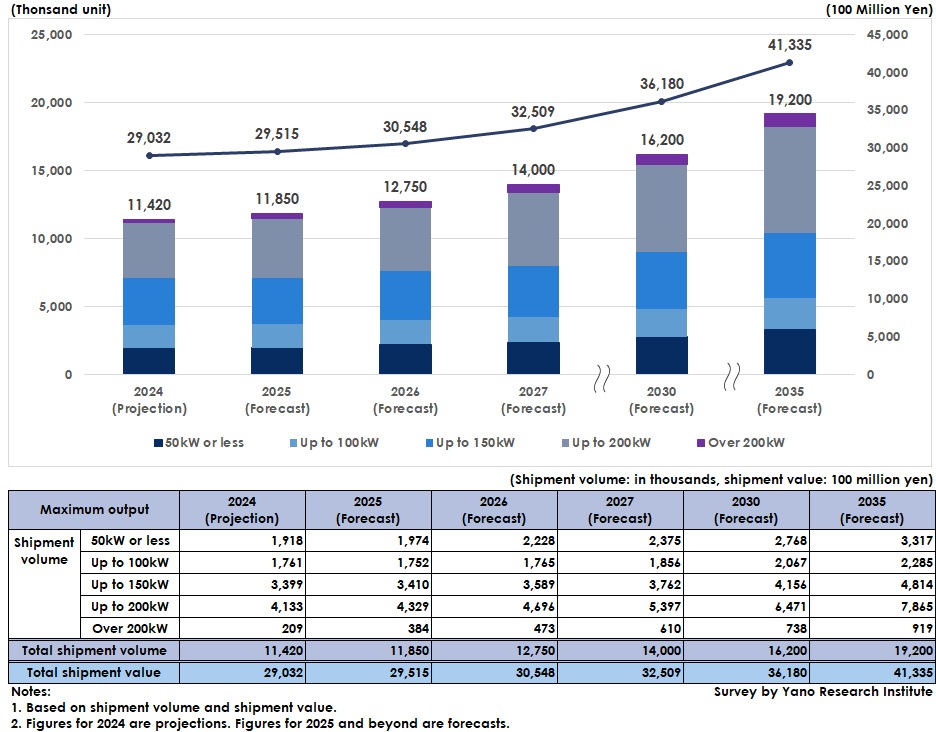No.3883
Global XEV Electric Traction Motor/eAxle Market: Key Research Findings 2025
Global Electric Traction Motor/eAxle Market for BEVs Expected to Reach 4.10 Trillion Yen by 2035
Yano Research Institute (the President, Takashi Mizukoshi) conducted a survey of the global market for xEVs and their key devices and components. The survey provided a market overview, technological trends, and the business strategies of leading manufacturers. It also included a forecast of the global xEV electric traction motor and eAxle market through 2035.

Market Overview
In 2024, the global BEV eAxle (electric axle) market is projected to reach 11.42 million units in shipment volume, or 2.9032 trillion yen in shipment value. For the eAxle shipment volume by maximum output, 50kW or less reached 1.918 million units (share: 16.8%), up to 100kW at 1.761 million units (15.4%), up to 150kW at 3.399 million units (29.8%), up to 200kW at 4.133 million units (36.2%), and over 200kW at 209,000 units (1.8%).
To meet the demand for shorter charging times, BEV battery voltage has increased from 400V to 800V, particularly in large and luxury BEVs. The adoption of 800V batteries has improved motor performance efficiency and increased eAxle output. To enhance driving performance and reduce noise emissions, all-wheel drive (AWD) models equipped with eAxles on both front and rear wheels are becoming more common among sports utility vehicles (SUVs) and large luxury BEVs. This trend is driving demand for eAxles with maximum output levels in the 150–200kW range.
Noteworthy Topics
Trend of BEV eAxles with “X in 1” Structure
In addition to the conventional "3-in-1" structure—where an eAxle consisting of three components, i.e., a motor, a gearbox, and an inverter—some Chinese models have integrated additional features into a single unit, leading to what is now called the “X-in-1” structure.
Depending on the number of components or features integrated into an eAxle, such as a DC-DC converter, an on-board charger (OBC), and a battery management system (BMS), these structures may be referred to as “4 in 1” or even “7 in 1”.
Further integration reduces the size and weight of the unit and brings various benefits to BEVs, such as simplified wiring, lower component costs, reduced development man-hours, and smaller installation space.
Consequently, the current mainstream 3-in-1 eAxle structure is expected to evolve into X-in-1 configurations, especially among mass-market models that prioritize shorter development periods and cost efficiency.
Future Outlook
Based on shipment volume, the global BEV eAxle market is projected to reach 16.2 million units by 2030, and 19.2 million units by 2035. In terms of shipment value, the market is expected to reach 3.618 trillion yen by 2030 and 4.1335 trillion yen by 2035.
As 800V vehicle platforms become more widespread—particularly in the Chinese market starting in the mid-2020s—AWD adoption is expected to increase among SUVs and luxury BEVs. This trend will drive demand for eAxles with maximum output exceeding 150kW. The global shipment volume of over-150kW eAxles (i.e., the combined total of units below 200kW and those over 200kW) is projected to reach 8.784 million units by 2035, which is expected to account for 45.8% of the total market—up from 38% in 2024.
Meanwhile, eAxles with a maximum output of 100kW or less will gradually expand in use for small BEVs designed for short-distance driving in urban areas of China and Europe. After 2031, the launch of small BEV market is expected in urban areas of Japan and other Asian countries, driven by improvements in charging infrastructure. As a result, the market size for these low-output eAxles is projected to reach 5.62 million units by 2035, including 3.317 million units under 50kW and 2.285 million units between 50kW and 100kW.
Research Outline
2.Research Object: Automakers, Tier 1 component manufacturers, power semiconductor manufacturers
3.Research Methogology: Face-to-face interviews (including online) by expert researchers, interviews by phone, and literature research
What are XEV Electric Traction Motors and eAxle ?
XEV electric traction motors convert electrical energy into the mechanical force to propel the vehicle. They replace traditional engines in transmitting torque to the wheels, enabling moves such as acceleration, deceleration, and regenerative braking. These motors serve as the main power source for battery electric vehicles (BEVs), and they supplement the propulsion of plug-in hybrid electric vehicles (PHEVs) and hybrid electric vehicles (HEVs), which require an engine.
An electric axle, or “eAxle,” is an integrated drive unit consisting of a motor, a gearbox, and an inverter. Consolidating these three components into one is referred to as a “3-in-1” structure, reducing the size and weight of the entire unit. This generates various benefits such as saving space, reducing power consumption, and increasing electric range. This miniaturization also improves flexibility in vehicle designs.
A BEV eAxle can be installed either at the front or rear wheels, or at both wheels to make the vehicle all-wheel drive (AWD). In the latter case, the eAxles are separated into a main unit and a subunit. The main unit uses its high-output traction motor to serve as the BEV's main drive. The subunit is equipped with a lower-output motor that assists with driving and control, thereby improving the vehicle’s performance and stability.
<Products and Services in the Market>
XEV electric traction motors, eAxle
Published Report
Contact Us
The copyright and all other rights pertaining to this report belong to Yano Research Institute.
Please contact our PR team when quoting the report contents for the purpose other than media coverage.
Depending on the purpose of using our report, we may ask you to present your sentences for confirmation beforehand.